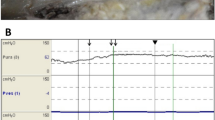Abstract
The anterior perineum contains the perineal body and muscles. It is the site of functional and pathological disorders, many of which have not yet been related to a precise cause. In the present study, we investigated the anatomy of the perineal muscles with the aim of elucidating their function in light of their anatomic structure. Knowledge of their functional-structural relationship is deemed necessary for the understanding of the disorders that affect this part of the perineum. The perineal muscles of 28 cadaveric specimens were studied by direct dissection, as well as histologically. Fifteen male and 13 female specimens were collected from 18 adult (mean (±SD) age 31.6 ± 9.8 years) and 10 neonate cadavers. Histological sections were stained with hematoxylin and eosin and Masson’s trichrome stain. The fibers of the superficial transverse perineal muscle proceeded medially to decussate in a criss-cross pattern with the muscle fibers of the contralateral muscle; a few muscle fibers passed directly without decussation. Similarly, the fibers of the deep transverse perineal muscle decussated with their fellows on the opposite side. The two decussation raphes constituted the main bulk of the perineal body. A ‘digastric’ pattern could be identified for each of the superficial transverse perineal muscle and deep transverse perineal muscle. This pattern allows simultaneous contraction of the muscles on both sides as a single unit. The perineal muscles, forming the floor of the anterior perineum, are apparently subjected to variations in intra-abdominal pressure, which, if exceeding normal physiological limits, may lead to weakening, subluxation and sagging of the perineal muscles and, eventually, to perineocele. Further studies to investigate the role of the perineal muscles in the functional disorders of the perineum are needed.
Similar content being viewed by others
References
Gufler H, Laubenberger J, De Gregorio G et al. (1999) Pelvic floor descent: Dynamic MR imaging using a half-Fourier RARE sequence. J Magn Reson Imaging 9, 378–83.
Helewa ME (1997) Episiotomy and severe perineal trauma: Of science and fiction. Can Med Assoc J 156, 811–13.
Henriksen TB, Bek KM, Hedegaard M et al. (1994) Methods and consequences of changes in use of episiotomy. BMJ 309, 1255–8.
Ho YH, Goh HS (1995) The neurophysiological significance of perineal descent. Int J Colorect Dis 10, 107–11.
Klein MC, Janssen PA, MacWilliam L et al. (1997) Determinants of vaginal-perineal integrity and pelvic floor functioning in childbirth. Am J Obstet Gynecol 176, 403–10.
Labrecque M, Baillargeon L, Dallaire M et al. (1997) Association between median episiotomy and severe perineal lacerations in primiparous women. Can Med Assoc 156, 797–802.
McMinn RMH (1990) Perineum. In: Last’s Anatomy: Regional and Applied, 8th edn (McMinn RMH, ed.). Churchill Livingstone, Edinburgh, 400–11.
Meyers-Helfgott MG, Helfgott AW (1999) Routine use of episiotomy in modern obstetrics: Should it be performed? Obstet Gynecol Clin 26, 305–25.
Shafik A (1983) A new concept of the anatomy of the anal sphincter mechanism and the physiology of defecation. XVIII. The levator dysfunction syndrome. A new syndrome with report of 7 cases. Coloproctology 5, 159–65.
Shafik A (1987) A concept of the anatomy of the anal sphjncter mechanism and the physiology of defecation. Dis Colon Rectum 30, 970–82.
Shafik A (1991) Constipation: Some provocative thoughts. J Clin Gastroenterol 13, 259–67.
Shafik A (1999) Physioanatomic entirety of external anal sphincter with bulbocavernosus muscle. Arch Androl 42, 45–54.
Shafik A, Asaad S, Dos S (2002) The histomorphologic structure of the levator ani muscle and its functional significance. Int Urogynecol J Pelvic Floor Dysfunct 13, 116–24.
Shafik A, El-Sibai O, Shafik AA et al. (2003) Effect of straining on perineal muscles and their role in perineal support. Identification of the straining-perineal reflex. J Surg Res 112, 162–7.
Skomorowska E, Hegedus V, Christiansen J (1988) Evaluation of perineal descent by defecography. Int J Colorect Dis 13, 191–4.
Timmons MC, Addison WA, Addison SB et al. (1992) Abdominal sacral colopexy in 163 women with posthysterectomy vaginal vault prolapse and enterocele. Evaluation of operative techniques. J Reprod Med 37, 323–7.
Warwick R, Williams PL (1975) The perineal muscles. In: Gray’s Anatomy (Warwick R, Williams PL, eds). Longman, Edinburgh, 530–2.
Woodman PJ, Graney DO (2002) Anatomy and physiology of the female perineal body with relevance to obstetrical injury and repair. Clin Anat 15, 321–34.
Author information
Authors and Affiliations
Corresponding author
Rights and permissions
About this article
Cite this article
Shafik, A., Ahmed, I., Shafik, A.A. et al. Surgical anatomy of the perineal muscles and their role in perineal disorders. Anato Sci Int 80, 167–171 (2005). https://doi.org/10.1111/j.1447-073x.2005.00109.x
Received:
Accepted:
Issue Date:
DOI: https://doi.org/10.1111/j.1447-073x.2005.00109.x




